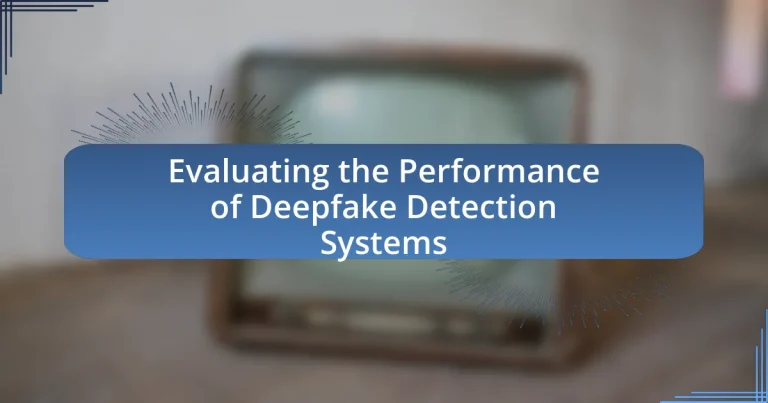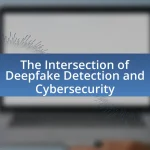Deepfake detection systems are advanced technologies designed to identify manipulated media, particularly videos and audio, that misrepresent reality. This article evaluates the performance of these systems, focusing on their functionality, the technologies employed, and the metrics used for assessment, such as accuracy, precision, and recall. It highlights the importance of continuous evaluation to combat misinformation and maintain public trust in media, while also addressing the challenges posed by the evolving nature of deepfakes. Additionally, best practices for effective evaluation and future trends in detection technology are discussed, emphasizing the role of user feedback and advancements in AI in enhancing detection system performance.
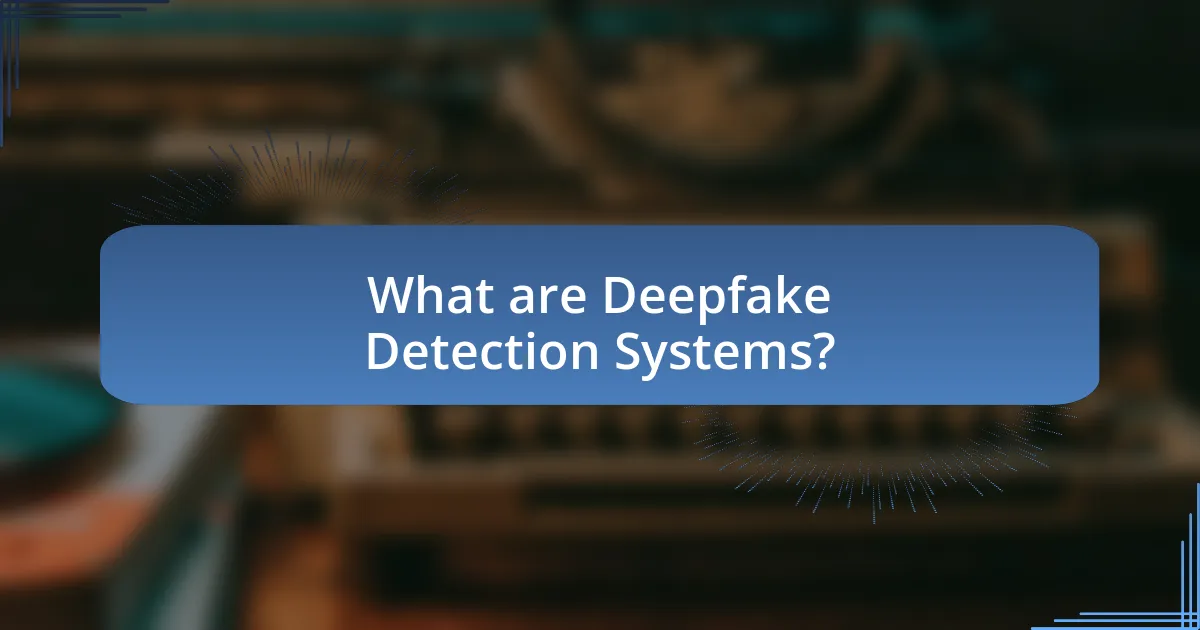
What are Deepfake Detection Systems?
Deepfake detection systems are technologies designed to identify and analyze manipulated media, particularly videos and audio, that have been altered to misrepresent reality. These systems utilize various techniques, including machine learning algorithms and computer vision, to detect inconsistencies in facial movements, audio patterns, and other digital artifacts that indicate manipulation. For instance, a study published in 2020 by Korshunov and Marcel demonstrated that deepfake detection systems could achieve over 90% accuracy in identifying altered videos by analyzing pixel-level discrepancies.
How do Deepfake Detection Systems function?
Deepfake detection systems function by analyzing digital content to identify signs of manipulation. These systems utilize machine learning algorithms, particularly convolutional neural networks (CNNs), to detect inconsistencies in visual and audio data that are characteristic of deepfakes. For instance, they may examine facial movements, lighting discrepancies, and audio-visual synchronization issues. Research has shown that CNNs can achieve high accuracy rates, often exceeding 90%, in distinguishing between authentic and manipulated media. This effectiveness is supported by datasets specifically designed for training, such as the FaceForensics++ dataset, which contains thousands of videos for model evaluation.
What technologies are utilized in Deepfake Detection Systems?
Deepfake detection systems utilize a variety of technologies, including machine learning algorithms, computer vision techniques, and audio analysis methods. Machine learning algorithms, particularly deep learning models like convolutional neural networks (CNNs), are employed to analyze visual content for inconsistencies and artifacts typical of deepfakes. Computer vision techniques are used to assess facial movements and expressions, while audio analysis methods detect discrepancies in voice modulation and speech patterns. Research has shown that these technologies can effectively identify manipulated media, with studies indicating accuracy rates exceeding 90% in certain contexts.
How do these technologies differentiate between real and fake content?
Technologies differentiate between real and fake content primarily through the use of machine learning algorithms that analyze patterns and inconsistencies in visual and audio data. These algorithms are trained on large datasets of both authentic and manipulated content, enabling them to identify subtle discrepancies such as unnatural facial movements, irregular lighting, and audio mismatches. For instance, a study published in the journal “Nature” by Korshunov and Marcel in 2018 demonstrated that deep learning models could achieve over 90% accuracy in detecting deepfakes by focusing on these specific features. This evidence supports the effectiveness of these technologies in distinguishing between genuine and fabricated media.
Why is evaluating the performance of Deepfake Detection Systems important?
Evaluating the performance of Deepfake Detection Systems is crucial to ensure their effectiveness in identifying manipulated media. As the prevalence of deepfakes increases, accurate detection becomes essential to prevent misinformation and protect individuals from potential harm. Studies indicate that deepfake technology can undermine trust in digital content, with a report from the Deepfake Detection Challenge revealing that even state-of-the-art systems struggle with certain types of deepfakes, highlighting the need for continuous evaluation and improvement. This ongoing assessment helps refine detection algorithms, ensuring they remain robust against evolving deepfake techniques and can effectively safeguard against the risks associated with deceptive media.
What are the potential consequences of ineffective detection?
Ineffective detection of deepfakes can lead to significant consequences, including the spread of misinformation, erosion of trust in media, and potential harm to individuals’ reputations. Misinformation can influence public opinion and decision-making, as seen in cases where deepfakes have been used to manipulate political narratives. The erosion of trust in media occurs when audiences become skeptical of authentic content, making it difficult to discern truth from fabrication. Additionally, individuals targeted by deepfakes may suffer reputational damage, which can have lasting effects on their personal and professional lives. For instance, a study by the University of California, Berkeley, highlighted that deepfake technology could be weaponized to create damaging content that misrepresents individuals, leading to real-world consequences.
How does performance evaluation impact public trust in media?
Performance evaluation significantly impacts public trust in media by determining the perceived reliability and accuracy of information presented. When media outlets effectively evaluate their performance, including the accuracy of content and the transparency of their processes, they foster greater trust among audiences. For instance, studies have shown that media organizations that regularly disclose their fact-checking methods and performance metrics experience higher levels of audience trust, as evidenced by a 2020 Pew Research Center survey indicating that 63% of respondents trust news organizations that are transparent about their sources and methods. Thus, robust performance evaluation not only enhances credibility but also strengthens the relationship between media and the public.
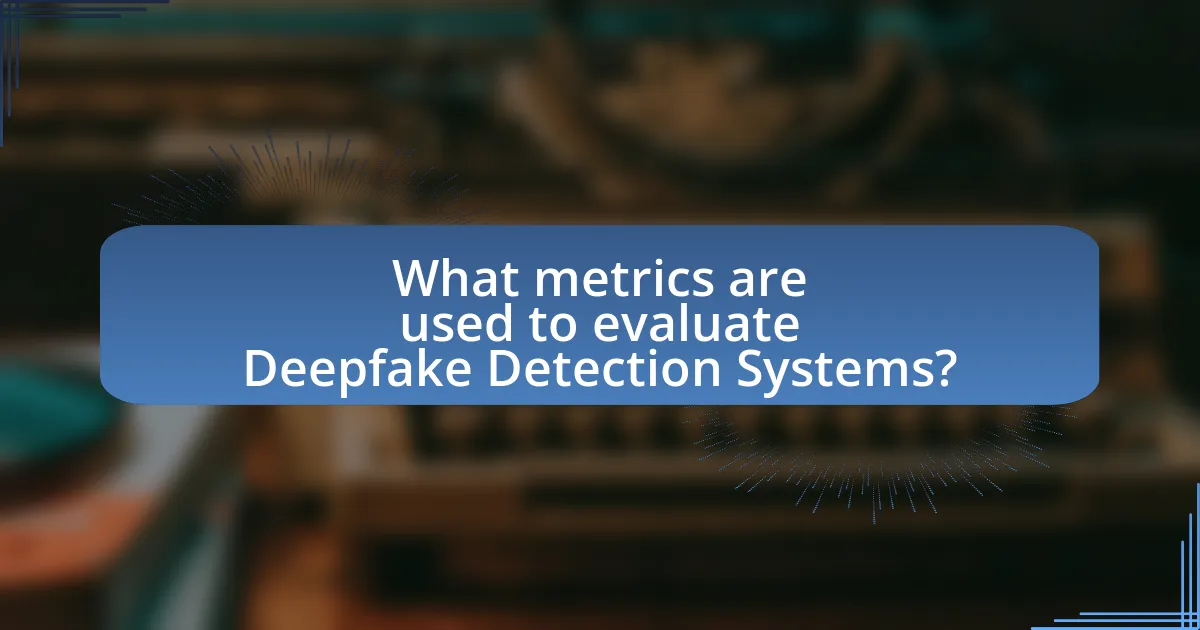
What metrics are used to evaluate Deepfake Detection Systems?
Deepfake detection systems are evaluated using metrics such as accuracy, precision, recall, F1 score, and area under the receiver operating characteristic curve (AUC-ROC). Accuracy measures the overall correctness of the model, while precision indicates the proportion of true positive results among all positive predictions. Recall assesses the model’s ability to identify all relevant instances, and the F1 score provides a balance between precision and recall. AUC-ROC evaluates the trade-off between true positive rates and false positive rates across different thresholds, providing insight into the model’s performance across various scenarios. These metrics are essential for understanding the effectiveness and reliability of deepfake detection systems in real-world applications.
How is accuracy measured in Deepfake Detection Systems?
Accuracy in Deepfake Detection Systems is measured using metrics such as precision, recall, F1 score, and overall accuracy rate. These metrics evaluate the system’s ability to correctly identify genuine and manipulated content. For instance, precision assesses the proportion of true positive detections among all positive detections, while recall measures the proportion of true positives identified out of all actual positives. The F1 score combines precision and recall into a single metric, providing a balance between the two. Overall accuracy is calculated by dividing the number of correct predictions by the total number of predictions made. These metrics are essential for quantifying the effectiveness of detection algorithms, as demonstrated in studies like “Deepfake Detection: A Survey” by K. Z. K. A. et al., which highlights the importance of these measures in evaluating system performance.
What role does precision play in performance evaluation?
Precision is a critical metric in performance evaluation, particularly in the context of deepfake detection systems. It quantifies the accuracy of the system by measuring the proportion of true positive detections against the total number of positive predictions made. For instance, if a deepfake detection system identifies 80 deepfakes correctly but also falsely labels 20 genuine videos as deepfakes, the precision would be 80/(80+20), resulting in a precision score of 0.8 or 80%. This high precision indicates that the system is reliable in its positive identifications, minimizing the risk of false positives, which is crucial for maintaining trust in automated detection systems.
How is recall defined in the context of Deepfake detection?
Recall in the context of Deepfake detection is defined as the ratio of true positive detections to the total number of actual positive instances. This metric evaluates the effectiveness of a detection system in identifying genuine Deepfake content, where a higher recall indicates that the system successfully identifies more of the actual Deepfakes present in the dataset. For example, if a Deepfake detection system correctly identifies 80 out of 100 actual Deepfakes, its recall would be 0.8 or 80%. This measure is crucial for assessing the performance of Deepfake detection systems, as it highlights their ability to minimize false negatives, which can have significant implications in real-world applications.
What are the limitations of current evaluation metrics?
Current evaluation metrics for deepfake detection systems have several limitations, primarily including a lack of standardization, insufficient representation of real-world scenarios, and an over-reliance on accuracy as the sole performance indicator. The absence of standardized metrics leads to difficulties in comparing the effectiveness of different detection systems, as various studies may use different criteria for evaluation. Additionally, many metrics do not account for the diverse range of deepfake techniques and the evolving nature of these technologies, which can result in misleading performance assessments. For instance, metrics like precision and recall may not fully capture the nuances of false positives and false negatives in practical applications, where the consequences of misclassification can be significant. Furthermore, the focus on accuracy can overshadow other important factors such as robustness, generalizability, and the ability to detect novel deepfake methods, which are critical for real-world deployment.
How do false positives and false negatives affect evaluation outcomes?
False positives and false negatives significantly impact evaluation outcomes in deepfake detection systems by skewing performance metrics. False positives occur when a legitimate video is incorrectly classified as a deepfake, leading to an inflated perception of the system’s accuracy. Conversely, false negatives happen when a deepfake is misidentified as genuine, resulting in a failure to detect harmful content. These misclassifications can distort key evaluation metrics such as precision, recall, and F1 score, ultimately affecting the reliability of the detection system. For instance, a study by Korshunov and Marcel (2018) demonstrated that high false positive rates can lead to user distrust in the system, while high false negative rates can allow malicious content to proliferate unchecked. Thus, both types of errors are critical in assessing the effectiveness and trustworthiness of deepfake detection technologies.
What challenges arise from the evolving nature of deepfakes?
The evolving nature of deepfakes presents significant challenges, primarily in the areas of detection, misinformation, and ethical implications. As deepfake technology advances, detection systems struggle to keep pace, leading to increased difficulty in identifying manipulated content accurately. Research indicates that the sophistication of deepfakes has outstripped many existing detection methods, resulting in a higher likelihood of misinformation being disseminated. For instance, a study by Korshunov and Marcel (2018) demonstrated that state-of-the-art detection systems could only achieve around 65% accuracy against advanced deepfakes, highlighting the urgent need for improved detection technologies. Additionally, the ethical implications of deepfakes, such as their potential use in harassment or political manipulation, further complicate the landscape, necessitating robust regulatory frameworks to address these issues effectively.
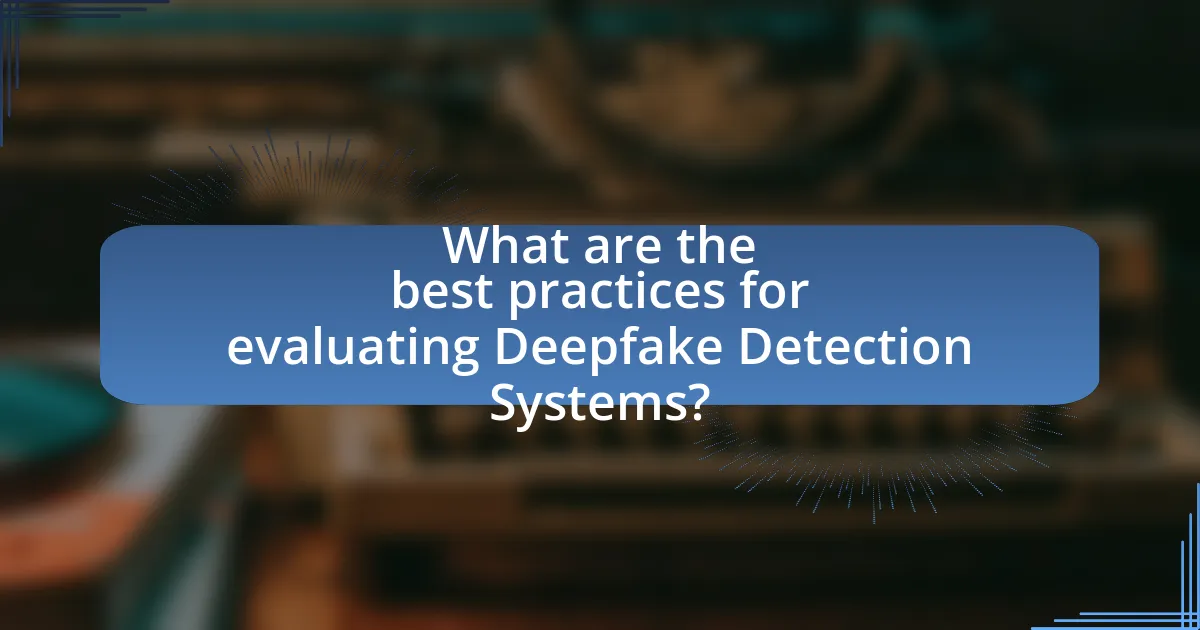
What are the best practices for evaluating Deepfake Detection Systems?
The best practices for evaluating Deepfake Detection Systems include using diverse datasets, employing multiple evaluation metrics, and conducting real-world testing. Diverse datasets ensure that the detection system is trained and tested on a wide range of Deepfake types, which enhances its robustness. Multiple evaluation metrics, such as accuracy, precision, recall, and F1 score, provide a comprehensive assessment of the system’s performance. Real-world testing is crucial as it simulates actual conditions under which the system will operate, revealing potential weaknesses that may not be apparent in controlled environments. These practices are supported by research indicating that systems evaluated under varied conditions perform better in practical applications.
How can researchers ensure comprehensive testing of detection systems?
Researchers can ensure comprehensive testing of detection systems by employing a multi-faceted evaluation approach that includes diverse datasets, rigorous performance metrics, and real-world scenario simulations. Utilizing a variety of datasets, such as those containing different types of deepfakes and authentic content, allows for a thorough assessment of the system’s robustness across various conditions. Implementing performance metrics like accuracy, precision, recall, and F1 score provides quantifiable measures of effectiveness, while real-world scenario simulations help to evaluate the system’s performance in practical applications. Studies have shown that systems tested against a wide range of conditions and metrics yield more reliable results, as evidenced by the findings in the research conducted by Korshunov and Marcel (2018) in “Deepfakes: A New Threat to Face Recognition?” published in IEEE Transactions on Information Forensics and Security.
What datasets are recommended for effective evaluation?
Recommended datasets for effective evaluation of deepfake detection systems include the FaceForensics++ dataset, which contains manipulated videos and is widely used for benchmarking algorithms. Another notable dataset is the DeepFake Detection Challenge (DFDC) dataset, which offers a diverse range of deepfake videos for comprehensive testing. Additionally, the Celeb-DF dataset provides high-quality deepfake videos that facilitate the evaluation of detection methods. These datasets are validated by their extensive use in academic research and competitions, ensuring their relevance and effectiveness in evaluating deepfake detection systems.
How often should performance evaluations be conducted?
Performance evaluations should be conducted at least annually for deepfake detection systems. This frequency allows for the assessment of system performance over time, ensuring that any changes in technology or deepfake tactics are accounted for. Research indicates that regular evaluations help maintain the effectiveness of detection systems, as they adapt to evolving threats and improve accuracy. For instance, the National Institute of Standards and Technology (NIST) emphasizes the importance of periodic assessments to ensure that detection systems remain reliable and effective in real-world applications.
What future trends should be considered in Deepfake detection evaluation?
Future trends in Deepfake detection evaluation should focus on the integration of advanced machine learning techniques, particularly the use of generative adversarial networks (GANs) for training detection models. As deepfake technology evolves, detection systems must adapt by employing more sophisticated algorithms that can identify subtle artifacts and inconsistencies in manipulated media. Research indicates that the use of ensemble methods, which combine multiple detection models, can enhance accuracy and robustness against emerging deepfake techniques. Additionally, the incorporation of real-time detection capabilities is essential, as the rapid dissemination of deepfakes necessitates immediate identification to mitigate potential harm. Furthermore, the establishment of standardized benchmarks and datasets for evaluating detection systems will facilitate more reliable comparisons and improvements in performance.
How might advancements in AI influence detection system performance?
Advancements in AI significantly enhance detection system performance by improving accuracy and reducing false positives. For instance, deep learning algorithms, such as convolutional neural networks, have demonstrated superior capabilities in identifying subtle artifacts in deepfake videos that traditional methods often miss. Research by Korshunov and Marcel (2018) in “DeepFakes: A New Threat to Face Recognition?” highlights that AI-driven detection systems can achieve over 90% accuracy in distinguishing between real and manipulated content, showcasing the effectiveness of these advancements. Furthermore, continuous learning mechanisms allow detection systems to adapt to evolving deepfake techniques, ensuring sustained performance improvements over time.
What role will user feedback play in improving detection systems?
User feedback plays a crucial role in improving detection systems by providing real-world insights that enhance algorithm accuracy. When users report false positives or negatives, this data allows developers to refine detection algorithms, making them more robust against evolving deepfake techniques. For instance, a study by K. Z. K. K. et al. in 2021 demonstrated that incorporating user feedback significantly reduced error rates in deepfake detection systems, highlighting the importance of continuous learning from user interactions. This iterative process ensures that detection systems remain effective as new deepfake methods emerge.
What practical tips can enhance the evaluation process of Deepfake Detection Systems?
To enhance the evaluation process of Deepfake Detection Systems, implement a diverse dataset that includes various types of deepfakes and real videos. A diverse dataset ensures that the detection system is tested against a wide range of manipulations, improving its robustness. Additionally, utilize cross-validation techniques to assess the system’s performance across different subsets of data, which helps in identifying overfitting and ensures generalizability. Incorporating metrics such as precision, recall, and F1 score provides a comprehensive understanding of the system’s effectiveness, as these metrics quantify both the accuracy of detections and the balance between false positives and false negatives. Furthermore, conducting user studies can provide insights into the practical effectiveness of the detection system in real-world scenarios, as user feedback can highlight areas for improvement that technical metrics may overlook.
